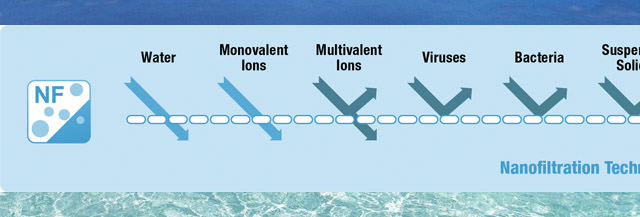The word “nano” is popping up just about everywhere these days. Many people are heralding nanobots and other forms of nanotechnology as the solution for all of our health and environmental problems. Others suggest that nanotechnology will cause just as many problems as it resolves. The truth is probably somewhere in between. There will be tremendous advantages, but there will certainly be risks as well.
How does nanofiltration work?
After hearing the terms, microfiltration and ultrafiltration, you may be wondering what sets nanofiltration apart. The difference between these forms of filtration comes down to the size of the pores in the membrane.
Nanofiltration uses a series of membranes that have nano-sized pores. The pores range from 1 to 10 nanometers in most cases. One nanometer is incredible small. It is .000000001 of one meter, in fact. At this size, nanofiltration removes not only bacteria, protozoa, and suspended solids but also viruses and microplastics.
You may be wondering how water can be efficiently filtered when the membranes have such small pores. Well, the answer involves hundreds of square meters of membranes. In other words, nanofiltration is currently not something that many people install in their homes. Its primary application is on an industrial scale.
The food processing and pharmaceutical industries are already employing nanofiltration for molecular separation and general purification. Most of you reading this site are probably wondering what is the alternative if nanofiltration is not available for domestic use.
The truth is, the closest thing to nanofiltration for home application is reverse osmosis, which we’ve talked about extensively on the site. As with reverse osmosis, nanofiltration can remove some of the minerals in the water. This is great news if you are trying to soften your water, but it is certainly not a benefit if your water is already lacking minerals.
It is for this reason that water may need to be re-mineralized in some cases. You can remineralize water by passing it through what’s known as a mineral bed, which contains important minerals like calcium and magnesium.
Reverse Osmosis compared to Nanofiltration
Reverse osmosis is slightly more discriminating when compared to nanofiltration. While nanofiltration removes almost everything, reverse osmosis truly removes everything. We believe a reverse osmosis system that remineralizes the water is best for the home. Nanofiltration requires a large area for all of the pores. Furthermore, the nanofiltration membrane is expensive to maintain and replace.
For those still looking for nanofiltration in the home, there are now some whole house nanofiltration systems available. These are robust systems that are capable of filtering the water for your entire household. A smaller application of nanofiltration doesn’t really make sense for a house as it would take ages for the water to filter.
This technology is almost certainly going to become more efficient. What’s already clear, though, is that there is nothing better on the market for removing contaminants. Heavy metals, traces of pharmaceuticals, all manner of bacteria and viruses, and even organic materials that you would want to avoid – all of these are removed by nanofiltration.
While it may not be something you would want or need to invest in at the moment, pay attention to this technology and don’t let it off your radar. In several years, it may be the most effective and efficient water purification technology on the market.







{ 0 comments… add one }